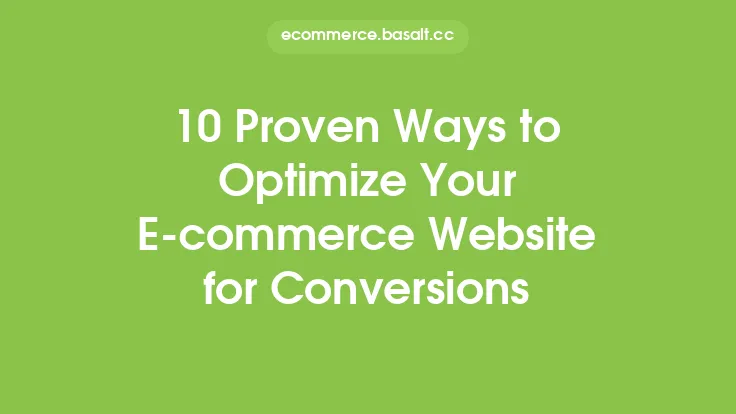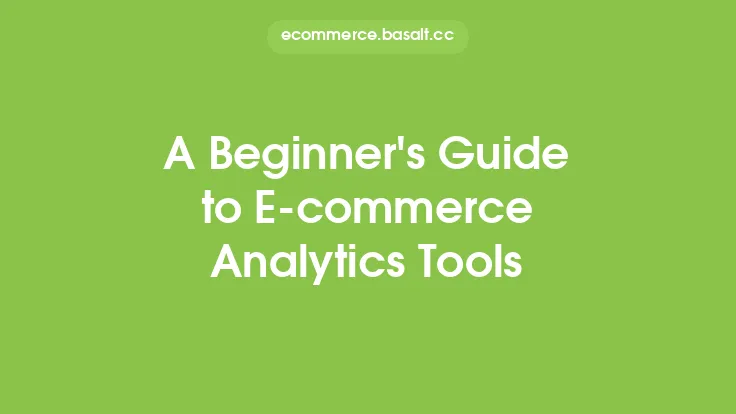To optimize an e-commerce store, it's essential to have a deep understanding of how customers interact with the site, what drives conversions, and where improvements can be made. This is where analytics comes in – a powerful tool that provides insights into customer behavior, helping store owners make data-driven decisions to boost sales, enhance user experience, and stay ahead of the competition. In this article, we'll delve into the world of analytics and explore how to use it to optimize an e-commerce store.
Understanding E-commerce Analytics
E-commerce analytics involves collecting, analyzing, and interpreting data from various sources, such as website traffic, customer interactions, and sales. This data is then used to identify trends, patterns, and areas for improvement. By leveraging analytics, store owners can gain a better understanding of their customers' needs, preferences, and pain points, enabling them to make informed decisions to drive business growth. There are several types of e-commerce analytics, including descriptive analytics, which provides insights into what has happened; predictive analytics, which forecasts what may happen; and prescriptive analytics, which recommends actions to take.
Setting Up E-commerce Analytics Tools
To get started with analytics, e-commerce store owners need to set up the necessary tools and platforms. Google Analytics is a popular choice, offering a range of features, including website tracking, goal setting, and e-commerce tracking. Other tools, such as Mixpanel, Adobe Analytics, and Piwik, also provide robust analytics capabilities. When setting up analytics tools, it's essential to ensure that all relevant data points are being tracked, including page views, bounce rates, conversion rates, and average order value. Additionally, store owners should consider integrating analytics tools with other platforms, such as customer relationship management (CRM) software and marketing automation tools.
Tracking Key E-commerce Metrics
To optimize an e-commerce store, it's crucial to track key metrics that provide insights into customer behavior and sales performance. Some essential metrics to monitor include conversion rates, which indicate the percentage of visitors who complete a purchase; average order value, which shows the average amount spent by customers; and customer lifetime value, which represents the total value of a customer over their lifetime. Other important metrics include cart abandonment rates, which highlight the percentage of customers who leave their carts without checking out; bounce rates, which indicate the percentage of visitors who leave the site without taking any further action; and return on ad spend (ROAS), which measures the revenue generated by advertising campaigns.
Analyzing Customer Behavior
Analytics provides valuable insights into customer behavior, enabling store owners to identify trends, patterns, and areas for improvement. By analyzing customer behavior, store owners can gain a better understanding of how customers interact with the site, what drives conversions, and where improvements can be made. Some key aspects of customer behavior to analyze include navigation paths, which show how customers move through the site; search queries, which highlight what customers are looking for; and product interactions, such as product views, adds to cart, and purchases. Additionally, store owners can use analytics to identify customer segments, such as demographics, location, and device type, and tailor marketing campaigns and user experiences accordingly.
Identifying Areas for Improvement
Analytics helps store owners identify areas for improvement, such as pages with high bounce rates, slow loading times, or low conversion rates. By analyzing these areas, store owners can pinpoint specific issues and develop targeted solutions to address them. For example, if a page has a high bounce rate, it may indicate that the content is not relevant or engaging, and store owners can revise the content to better meet customer needs. Similarly, if a page has a slow loading time, it may be due to large image files or excessive code, and store owners can optimize the page to improve loading times.
Creating Data-Driven Marketing Campaigns
Analytics provides the insights needed to create data-driven marketing campaigns that drive conversions and revenue. By analyzing customer behavior, store owners can identify opportunities to personalize marketing campaigns, such as targeting specific customer segments or creating tailored promotions. Additionally, analytics helps store owners measure the effectiveness of marketing campaigns, enabling them to adjust and optimize campaigns for better results. Some key metrics to track when creating data-driven marketing campaigns include click-through rates, conversion rates, and return on investment (ROI).
Optimizing the User Experience
Analytics plays a critical role in optimizing the user experience, enabling store owners to identify areas for improvement and develop targeted solutions to enhance customer satisfaction. By analyzing customer behavior, store owners can identify pain points, such as difficult navigation or slow loading times, and develop solutions to address them. Some key aspects of the user experience to optimize include page layout, content, and mobile responsiveness. Additionally, store owners can use analytics to identify opportunities to personalize the user experience, such as offering tailored product recommendations or streamlining the checkout process.
Measuring the Impact of Changes
When making changes to an e-commerce store, it's essential to measure the impact of those changes using analytics. This involves tracking key metrics before and after the changes, such as conversion rates, average order value, and customer satisfaction. By measuring the impact of changes, store owners can determine whether the changes had a positive or negative effect and make adjustments accordingly. Some key metrics to track when measuring the impact of changes include A/B testing results, which compare the performance of different versions of a page or feature; user feedback, which provides insights into customer satisfaction; and sales data, which shows the revenue generated by the changes.
Best Practices for E-commerce Analytics
To get the most out of e-commerce analytics, store owners should follow best practices, such as regularly reviewing and analyzing data, setting clear goals and objectives, and using data to inform decision-making. Additionally, store owners should ensure that analytics tools are properly set up and configured, and that all relevant data points are being tracked. Some other best practices include using segmentation to analyze specific customer groups, creating custom dashboards to track key metrics, and using automation to streamline analytics processes.
Common Challenges and Solutions
Despite the many benefits of e-commerce analytics, store owners may encounter common challenges, such as data overload, inaccurate data, or difficulty interpreting results. To overcome these challenges, store owners can use solutions such as data visualization tools, which help to simplify complex data; data validation techniques, which ensure data accuracy; and analytics consulting services, which provide expert guidance and support. Additionally, store owners can use analytics communities and forums to connect with other store owners, share knowledge, and learn from their experiences.
Future of E-commerce Analytics
The future of e-commerce analytics is exciting, with emerging trends and technologies, such as artificial intelligence, machine learning, and the Internet of Things (IoT), set to revolutionize the way store owners analyze and interpret data. These technologies will enable store owners to gain even deeper insights into customer behavior, predict future trends, and make more informed decisions. Some key areas to watch include predictive analytics, which uses machine learning algorithms to forecast future events; real-time analytics, which provides instant insights into customer behavior; and voice analytics, which analyzes customer interactions with voice assistants. By staying ahead of the curve and embracing these emerging trends and technologies, store owners can unlock new opportunities for growth, innovation, and success.





